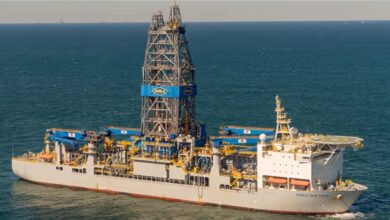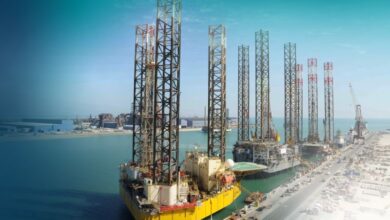Environmentally Friendly Drilling program targets low-impact drilling technologies
By adopting low-impact technologies, industry can change perceptions, open off-limits acreage
By Richard C Haut, Houston Advanced Research Center; David Burnett, Texas A&M University; Tom Williams, TerraPlatforms; Gene Theodori, Sam Houston State University
Industry has made great strides in protecting the environment while increasing oil and natural gas production in the US. Producers, however, still face daunting challenges to effectively produce more natural gas in environmentally sensitive areas.
The Houston Advanced Research Center (HARC) is collaborating with Texas A&M University and TerraPlatforms to manage the Environmentally Friendly Drilling Systems (EFD) program, which combines new low-impact technologies that reduce the footprint of drilling activities, integrates lightweight drilling rigs with reduced-emission engine packages, addresses on-site waste management, optimizes the systems to fit the needs of specific development sites and provides stewardship of the environment.
The EFD partnership consists of universities, national laboratories, oil and gas producers and service companies, environmental organizations and government agencies. The objective is to identify, develop and demonstrate cost-effective technologies that reduce environmental trade-offs and allow operations in environmentally sensitive areas that are currently off-limits.
The EFD program began in 2005 with co-funding from the US Department of Energy (DOE) and has shown that the industry can achieve significant reduction in environmental impact if low-impact technologies are combined into a complete system. The program also offers a collaboration to address public concerns on the development of unconventional gas resources in environmentally sensitive areas.
To inform the public of the industry’s environmental advancements in technology, the EFD program is developing a computer-based model to select complementary environmentally friendly technologies for E&P operations, along with an EFD scorecard to measure performance. The scorecard concept engages all stakeholders in identifying technologies and systems that can be used to recover unconventional natural gas reserves with the lowest possible environmental footprint. The model and scorecard are based on the principles of “what gets measured gets done” and “what gets identified gets dealt with.”
Use of the EFD scorecard provides a gauge of a program’s effectiveness in adapting to the environment. The scorecard, still under development, may be used by the industry to measure the balance between environmental trade-offs and costs. The EFD program is expected to result in greater access, reasonable regulatory controls, lower development cost and reduction of the environmental footprint associated with oil and gas operations.
The program may also increase the public’s and regulators’ acceptance of E&P operations in environmentally sensitive areas, thereby adding reserves.
The EFD program disseminates technology to successfully produce oil and gas while addressing environmentally sensitive issues. For example, it is identifying, developing and testing technologies that may be applicable to the Bakken shale development, a play offering the equivalent of over 3 billion bbl of oil for development. Certainly, the Fayetteville and the Haynesville plays could also benefit. Workshops are held to educate industry about cost-effective technologies.
E&P companies face restrictions, and in some cases complete prohibitions, that prevent operations in sensitive areas in the continental United States. Environmental constraints, including laws, regulations and implementation procedures, can limit natural gas development and production on both federal and private lands. More than 30 environmental policy and regulatory impediments to domestic natural gas production have been identified and documented. Yet US stakeholders are united in the desire to understand the environmental trade-offs necessary to secure energy resources and improve the energy independence of the country.
Data collected in a previously funded EFD project shed insight on the way the public perceives environmentally friendly drilling technologies. These data reveal that the majority of citizens are in favor of eliminating or relaxing governmental regulations that limit oil and natural gas exploration and production in environmentally sensitive settings as the energy industry adopts and uses a more environmentally friendly approach.
A significant majority of survey respondents indicated that, as an environmentally friendly approach is implemented, current governmental regulations should be eliminated or relaxed. In environmentally sensitive areas such as coastal wetlands, desert ecosystems and hardwood forests, the percentages of respondents who agreed that current regulations could be eliminated or relaxed (i.e., relaxed greatly, relaxed moderately or relaxed slightly) were 68%, 72% and 63%, respectively.
According to recommendations by the National Petroleum Council (NPC), access to indigenous resources is essential for reaching North America’s full supply potential. New discoveries in mature North American basins represent the largest component of the supply outlook.
However, the trend towards more leasing and regulatory land restrictions in the Rocky Mountain region and the Outer Continental Shelf (OCS) is occurring in precisely the areas that hold significant potential for natural gas production. The NPC evaluated the effect of removing the OCS moratoria and of reducing the impact of conditions of approval in the Rocky Mountains – a potential addition of 3 billion cu ft/day by 2020.
Land-use policies of federal, state and local governments have not kept pace with technological advances that allow for exploration and production while protecting sensitive areas. Technical advances have reduced the number and size of onshore drilling sites and production facilities. The federal government has continued to set federal lands off-limits to development through legislation, executive orders, and regulatory and administrative decisions.
Moreover, an increasingly complex and costly maze of statutory and regulatory requirements effectively places additional lands off-limits to development, even though they are technically available for leasing.
The US Bureau of Land Management (BLM) – or Forest Service (FS), for actions on National Forest System lands – are responsible for ensuring compliance with the National Environmental Policy Act (NEPA). During reviews of development proposals that encompass multiple wells in a specific area, the BLM, the surface management agency, or the agency’s or operator’s environmental contractor conduct an environmental analysis and prepare a document in conformance with NEPA requirements and Council on Environmental Quality (CEQ) regulations.
Regardless of which agency, entity or individual prepares the document, the BLM (or FS) must concur with the content prior to issuing a decision document. In the case of National Forest System lands, where the environmental analysis is conducted jointly with the BLM, each agency issues its own decision.
The extent of the environmental analysis process and the time frame for issuance of a decision depend on the complexity of the proposed action and resulting analysis, the significance of the environmental effects disclosed, and the completion of appropriate consultation processes.
The EFD program targets new and emerging technologies that enable low-impact operations. Some of these were identified in the program co-funded by the DOE and a 2005-2008 joint industry project led by Texas A&M University and HARC.
In general, it is difficult to select the best combination of EFD technologies for a given site because there are many possible combinations, many different evaluation criteria, and many different environments. The program identified critical technologies appropriate for low-impact systems (i.e., combination of technologies) compatible with ecologically sensitive or off-limits areas.
The EFD program has become an industry leader and a clearing house of technologies that enable drilling and production with a goal of zero environmental impact, or as minimal an impact as possible. It has shown that the industry can achieve more than 90% reduction in environmental impact if low-impact technologies are combined into a complete system. More than 120 specific technologies have been identified.
A prototype Systems Engineering Methodology Model has been developed to optimize selection of these technologies for specific well plans. Additionally, a scorecard has been conceived to evaluate environmental impact of different processes and practices and to allow comparison among different options.
By minimizing the environmental objections to development, companies may encounter less resistance to development, find permitting efforts less onerous, and realize significant financial savings in field cleanup and remediation after drilling operations. The results may be (1) less costly development of unconventional resources and (2) gas brought to market in less time with fewer environmental objections.
One conclusion from the previously funded program is that public acceptance for oil and gas operations increased by 20% when EFD technologies were used. Significant new gas reserves from unconventional resources could be realized if the increase in public acceptance offsets objections to development.
Small producers and entrepreneurial companies can also benefit if they have developed technology but do not have the resources to market their products or processes to different areas of the country. The program offers a way to clearly identify how a technology fits into a low-impact system.
The success of the EFD effort will enable industry to identify environmental trade-offs associated with harvesting energy resources throughout the continental US. It offers a system and infrastructure that allows development, testing and technology transfer of low-impact E&P practices to environmentally sensitive areas of the country.
The impact of this transfer is expected to reduce the opposition to development, reduce the footprint of drilling operations, create a basis of comparison of technology, and provide regulators and service providers with the means to assure new systems will perform as intended and reduce the risk taken on by operators, service providers and regulators.
There are significant tight gas sands resources throughout sensitive ecosystems and significant shale gas resources throughout the semi-arid ecosystem of New Mexico, Colorado and Appalachia. More than 200 trillion cu ft of gas is technically recoverable, and the biggest barrier to their development is the environmental concern of the public and elected officials.
The EFD program targets these environmentally sensitive ecosystems by enabling these reserves to be harvested in an environmentally sensitive manner. If widespread adoption of low-impact drilling and production practices is achieved, it is expected that as much as one-third of that resource could be developed, representing more than 50 trillion cu ft of gas.
Development activities are under way in the massive Marcellus Shale in the northeastern US. In early 2008, reserves were estimated at more than 500 trillion cu ft of natural gas. Using the same horizontal drilling and hydraulic fracturing methods that had previously been applied in the Barnett Shale, perhaps 10% of that gas (50 trillion cu ft) might be recoverable, enough to supply the entire United States for about two years. There is concern on how to develop these deposits in an environmentally friendly manner.
Environmental benefits from providing a reduced footprint for energy resource recovery operations should not be underestimated. Federal lands held in trust for the public could be leased for gas development with assurances that the environment would not be harmed. In addition, further restrictions to lands may be avoided.
In areas where air emissions are of concern, the selection of low- or no-emission power systems could be utilized. In National Parks where operations are of concern, the EFD program can identify practices with reduced footprint, minimizing roads and access points. Pad-less drilling and other minimally invasive technologies can substantially reduce potential damage to habitats.
Having a program that has the potential to “lighten the impact” of gas drilling in environmentally sensitive areas such as public lands in the West, urban areas in the South and Gulf Coast, and forests and recreational areas in the Northeast is extremely important. Gas leases beneath these properties are owned by private companies, not the government. Only by setting environmentally responsible standards can public officials protect the environment while providing access to these resources.
The overall concept of the EFD program is not to accept the prevalent opinion that government ownership and oversight is the answer to protecting the environment. Rather, it’s that private stewards continue to be the best stewards. On the whole, private stewards take pride in managing their land, and technology can provide many of the methods to accomplish this.
Article references:
USGS Study Extent of Bakken Oil Shale Development in North Dakota, Montana, and Canada.
Elcock, Deborah: ‘Environmental Policy and Regulatory Constraints to Natural Gas Production,’ ANL/EAD/04-1, Argonne National Laboratory, December 2004.
Theodori, G.L. and H. Lyke-Ho-Gland. 2008. Energy Resources and Natural Environments Survey of Texans: An Illustrative Summary. Huntsville, TX: Sam Houston State University.
Balancing Natural Gas Policy – Fueling the Demands of a Growing Economy Volume I Summary of Findings and Recommendations, National Petroleum Council, September 25, 2003.
Valko, Peter, “How is Your Barnett Shale Well Doing?” a Crisman Institute Lecture, May 30, 2008 Texas A&M University.
Engelder, Terry and Lash, Gary (2008). Unconventional Natural Gas Reservoir Could Boost U.S. Supply. Penn State Live.
This article is based on a presentation at the IADC Health, Safety, Environment & Training Conference & Exhibition, 3-4 February 2009, Houston, Texas.




